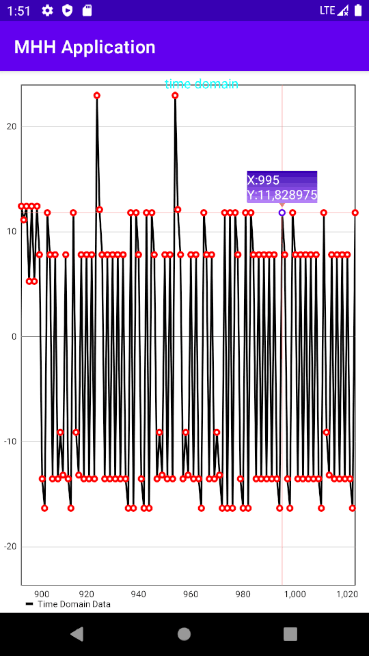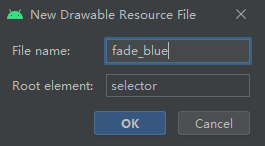MPAndroidChart
想要运用好本篇博客,读者至少需要掌握 Android 开发有关 Activity 的部分,并且对 MPAndroidChart 有简单的了解。本文是傻瓜式教程,更多需求请查看官方文档。
下面是图表画出来的样子~如果你觉得可能会对你有帮助,那么就接着往下看吧,冲!

基本使用步骤
【注意】chart 使用分为两大部分,第一部分可以实现基本绘图,第二部分便是 MarkerView——点击出现具体数据。
1.添加依赖
在 project 的 build.gradle 中添加依赖
allprojects {
repositories {
...
maven { url 'https://jitpack.io' }
}
}
在 app 的 build.gradle 中添加依赖:
dependencies {
implementation 'com.github.PhilJay:MPAndroidChart:v3.1.0'
}
2.配置 xml
在 Activity 对应的 Layout.xml 中配置所要使用的图表——可以把它看做一个控件,除了 android:id 属性外,其他需要自行配置。
<com.github.mikephil.charting.charts.LineChart
android:id="@+id/mChart"
android:layout_width="match_parent"
android:layout_height="match_parent"
android:layout_marginTop="100dp"
android:layout_marginLeft="5dp"
android:layout_marginRight="5dp"
android:layout_marginBottom="10dp"/>
3. java 配置图表“骨架”
新建一个包 util,新建一个类 chart_util,这个类完成图表的基本配置和添加删除数据功能。代码如下:
package “你滴包名🤩”;
import android.graphics.Color;
import com.github.mikephil.charting.charts.LineChart;
import com.github.mikephil.charting.components.Description;
import com.github.mikephil.charting.components.Legend;
import com.github.mikephil.charting.components.XAxis;
import com.github.mikephil.charting.components.YAxis;
import com.github.mikephil.charting.data.Entry;
import com.github.mikephil.charting.data.LineData;
import com.github.mikephil.charting.data.LineDataSet;
import com.github.mikephil.charting.interfaces.datasets.ILineDataSet;
import com.github.mikephil.charting.utils.ColorTemplate;
public class chart_util {
public static void chart_init(LineChart chart) {
//chart.setOnChartValueSelectedListener(this);
// enable description text
chart.getDescription().setEnabled(true);
// enable touch gestures
chart.setTouchEnabled(true);
/****************设置描述信息*************/
Description description = new Description();
description.setText("description here");
description.setPosition(700, 50);
description.setTextColor(Color.CYAN); //青色
description.setTextSize(15);
chart.setDescription(description); //设置图表描述信息
chart.setNoDataText("No chart data available! Try to figure it."); //没有数据时显示的文字
chart.setNoDataTextColor(Color.CYAN); //没有数据时显示文字的颜色
chart.setDrawGridBackground(false); //chart 绘图区后面的背景矩形将绘制
chart.setDrawBorders(true); //绘制图表边框的线
// enable scaling and dragging
chart.setDragEnabled(true);
chart.setScaleEnabled(true);
chart.setDrawGridBackground(false);
//set chart 动画~
//chart.animateX(8000);
// if disabled, scaling can be done on x- and y-axis separately
chart.setPinchZoom(false);
// set an alternative background color
//chart.setBackgroundColor(0x4169E1FF);
LineData data = new LineData();
data.setValueTextColor(Color.BLACK);
// add empty data
chart.setData(data);
// get the legend (only possible after setting data)
Legend l = chart.getLegend();
// modify the legend ...
l.setForm(Legend.LegendForm.LINE);
l.setTextColor(Color.BLACK);
//x轴配置
XAxis xl = chart.getXAxis();
//xl.setTypeface(tfLight);
xl.setTextColor(Color.BLACK);
xl.setDrawGridLines(false);
xl.setAvoidFirstLastClipping(true);
xl.setEnabled(true);
xl.setPosition(XAxis.XAxisPosition.BOTTOM); //X轴文字显示位置
//左y轴配置
YAxis leftAxis = chart.getAxisLeft();
leftAxis.setTextColor(Color.BLACK);
leftAxis.setAxisMaximum(30f);
leftAxis.setAxisMinimum(0f);
leftAxis.setDrawGridLines(true);
//右y轴配置
YAxis rightAxis = chart.getAxisRight();
rightAxis.setEnabled(false);
}
public static void addEntry(LineChart chart, float Concentration_data) {
LineData data = chart.getData();
YAxis leftAxis = chart.getAxisLeft();
if (data != null) {
ILineDataSet set = data.getDataSetByIndex(0);
// set.addEntry(...); // can be called as well
if (set == null) {
set = createSet();
data.addDataSet(set);
}
data.addEntry(new Entry(set.getEntryCount(), Concentration_data), 0);
leftAxis.setAxisMaximum(data.getYMax() + 1);
leftAxis.setAxisMinimum(data.getYMin() - 1);
data.notifyDataChanged();
chart.notifyDataSetChanged();
chart.setVisibleXRangeMaximum(128); //设置一次最多显示的数据个数
chart.moveViewToX(data.getEntryCount());
}
}
private static LineDataSet createSet() {
LineDataSet set = new LineDataSet(null, "Time Domain Data");
set.setAxisDependency(YAxis.AxisDependency.LEFT);
set.setColor(Color.BLACK);
set.setCircleColor(Color.RED);
set.setLineWidth(2f);
set.setCircleRadius(4f);
set.setFillAlpha(65);
set.setFillColor(ColorTemplate.getHoloBlue());
set.setHighLightColor(Color.rgb(244, 117, 117));
set.setValueTextColor(Color.RED);
set.setValueTextSize(7f);
set.setDrawValues(true);
return set;
}
}
4. Activity 中使用 chart
步骤:
-
导入相关包,这一步可以省略,代码复制进去后,自行找错误部分导入即可
import androidx.appcompat.app.AppCompatActivity; import android.graphics.Color; import android.os.Bundle; import android.text.InputFilter; import com.example.activitytest.R; import com.example.activitytest.databinding.ChartLayoutBinding; import com.example.activitytest.util.chart_util; import com.github.mikephil.charting.charts.LineChart; import com.github.mikephil.charting.components.Description; import com.github.mikephil.charting.components.Legend; import com.github.mikephil.charting.data.Entry; import com.github.mikephil.charting.data.LineData; import com.github.mikephil.charting.data.LineDataSet; import com.github.mikephil.charting.interfaces.datasets.ILineDataSet; import java.util.ArrayList; import java.util.Random; -
在需要设置 chart 的 Activity 中,加入这些全局变量:
private LineChart chart; -
在
onCreate()方法中加入如下代码,注意dataShowMhh()这个方法是向 Chart 中添加数据的方法,各位应该根据自己的需求,更改这个方法的相关内容。chart = (LineChart) findViewById(R.id.mChart); //获取对象——也可使用 ViewBinding,但是推荐直接复制这个进去,万无一失! chart_util.chart_init(chart); //初始化刚刚获取的对象——折线图 dataShowByMhh(); //静态画图 -
在你的 xxxActivity 类中加入如下代码,用来给表格加入数据、退出时取消绑定服务以及广播监听:
private void dataShowByMhh() { double[] data = {-16.309092, 11.828975......}; for (int i = 0; i < data.length; i++){ chart_util.addEntry(chart, (float) data[i]); } } @Override protected void onDestroy() { super.onDestroy(); }
完成以上步骤,你的 Activity 就可以绘图了,但是要想点击某个具体点,出现其信息,需要执行以下步骤:
MarkerView 配置步骤
0.设置背景图片
在 drawable 文件夹下,添加点击某点出现的视图背景。
添加背景:
- 右键 drawable 文件夹,New 👉 Drawable Resource File

-
命名为 fade_blue

-
在 fade_blue.xml 文件加入代码:
<?xml version="1.0" encoding="utf-8"?> <shape xmlns:tools="http://schemas.android.com/tools" xmlns:android="http://schemas.android.com/apk/res/android" tools:ignore="ResourceName" android:shape="rectangle"> <gradient android:startColor="@color/design_default_color_primary_variant" android:endColor="@color/purple_200" android:angle="270" /> </shape>
添加点击高亮
- 与上面步骤一致,右键 drawable 文件夹,New 👉 Drawable Resource File

-
命名为 ic_brightness_curve_point,同上。
-
在 ic_brightness_curve_point.xml 中加入代码:
<?xml version="1.0" encoding="utf-8"?> <shape xmlns:android="http://schemas.android.com/apk/res/android" android:shape="oval" > <solid android:color="@color/white" /> <stroke android:width="2dp" android:color="@color/design_default_color_primary" /> <size android:width="8dp" android:height="8dp" /> </shape>
1.重写 MarkerView
最好是在刚刚的 util 包中,新建一个类,命名为:CustomMPLineChartMarkerView,再添加以下代码:
package “你的包名别忘改~😨”;
import android.content.Context;
import android.graphics.Bitmap;
import android.graphics.BitmapFactory;
import android.graphics.Canvas;
import android.graphics.Paint;
import android.graphics.Path;
import android.graphics.RectF;
import android.graphics.drawable.Drawable;
import android.os.Build;
import android.util.TypedValue;
import android.widget.TextView;
import com.example.activitytest.R;
import com.github.mikephil.charting.charts.Chart;
import com.github.mikephil.charting.components.MarkerView;
import com.github.mikephil.charting.data.CandleEntry;
import com.github.mikephil.charting.data.Entry;
import com.github.mikephil.charting.highlight.Highlight;
import com.github.mikephil.charting.utils.Utils;
public class CustomMPLineChartMarkerView extends MarkerView {
private final int DEFAULT_INDICATOR_COLOR = 0xff9966FF;//指示器默认的颜色——淡紫色
private final int ARROW_HEIGHT = dp2px(5); // 箭头的高度
private final int ARROW_WIDTH = dp2px(10); // 箭头的宽度
private final float ARROW_OFFSET = dp2px(2);//箭头偏移量
private final float BG_CORNER = dp2px(2);//背景圆角
private final TextView tvContent;//文本
private Bitmap bitmapForDot;//选中点图片
private int bitmapWidth;//点宽
private int bitmapHeight;//点高
public CustomMPLineChartMarkerView(Context context) {
super(context, R.layout.layout_for_custom_marker_view);
tvContent = findViewById(R.id.tvContent);
//图片自行替换
bitmapForDot = getBitmap(context, R.drawable.ic_brightness_curve_point);
if (bitmapForDot != null) {
bitmapWidth = bitmapForDot.getWidth();
bitmapHeight = bitmapForDot.getHeight();
}
}
private static Bitmap getBitmap(Context context, int vectorDrawableId) {
Bitmap bitmap = null;
if (Build.VERSION.SDK_INT > Build.VERSION_CODES.LOLLIPOP) {
Drawable vectorDrawable = context.getDrawable(vectorDrawableId);
bitmap = Bitmap.createBitmap(vectorDrawable.getIntrinsicWidth(),
vectorDrawable.getIntrinsicHeight(), Bitmap.Config.ARGB_8888);
Canvas canvas = new Canvas(bitmap);
vectorDrawable.setBounds(0, 0, canvas.getWidth(), canvas.getHeight());
vectorDrawable.draw(canvas);
} else {
bitmap = BitmapFactory.decodeResource(context.getResources(), vectorDrawableId);
}
return bitmap;
}
@Override
public void refreshContent(Entry e, Highlight highlight) {
if (e instanceof CandleEntry) {
CandleEntry ce = (CandleEntry) e;
tvContent.setText(Utils.formatNumber(ce.getHigh(), 6, true));
} else {
tvContent.setText(" X:"+Utils.formatNumber(e.getX(), 0, false)+"\n Y:"
+Utils.formatNumber(e.getY(), 6, true)+" ");
}
super.refreshContent(e, highlight);
}
@Override
public void draw(Canvas canvas, float posX, float posY) {
Chart chart = getChartView();
if (chart == null) {
super.draw(canvas, posX, posY);
return;
}
//指示器背景画笔
Paint bgPaint = new Paint();
bgPaint.setStyle(Paint.Style.FILL);
bgPaint.setAntiAlias(true);
bgPaint.setColor(DEFAULT_INDICATOR_COLOR);
//剪头画笔
Paint arrowPaint = new Paint();
arrowPaint.setStyle(Paint.Style.FILL);
arrowPaint.setAntiAlias(true);
arrowPaint.setColor(DEFAULT_INDICATOR_COLOR);
float width = getWidth();
float height = getHeight();
int saveId = canvas.save();
//移动画布到点并绘制点
canvas.translate(posX, posY);
if (bitmapForDot != null) {
canvas.drawBitmap(bitmapForDot, -(float) bitmapWidth / 2f, -(float) bitmapHeight / 2f, null);
}
//画指示器
Path path = new Path();
RectF bRectF;
if (posY < height + (float)ARROW_HEIGHT + ARROW_OFFSET + (float)bitmapHeight / 2f) {//处理超过上边界
//移动画布并绘制三角形和背景
canvas.translate(0, height + (float)ARROW_HEIGHT + ARROW_OFFSET + (float)bitmapHeight / 2f);
path.moveTo(0, -(height + (float)ARROW_HEIGHT));
path.lineTo((float)ARROW_WIDTH / 2f, -(height - BG_CORNER));
path.lineTo(- (float)ARROW_WIDTH / 2f, -(height - BG_CORNER));
path.lineTo(0, -(height + (float)ARROW_HEIGHT));
bRectF=new RectF(-width / 2, -height, width / 2, 0);
canvas.drawPath(path, arrowPaint);
canvas.drawRoundRect(bRectF, BG_CORNER, BG_CORNER, bgPaint);
canvas.translate(-width / 2f, -height);
} else {//没有超过上边界
//移动画布并绘制三角形和背景
canvas.translate(0, -height - (float)ARROW_HEIGHT - ARROW_OFFSET - (float)bitmapHeight / 2f);
path.moveTo(0, height + (float)ARROW_HEIGHT);
path.lineTo((float)ARROW_WIDTH / 2f, height - BG_CORNER);
path.lineTo(- (float)ARROW_WIDTH / 2f, height - BG_CORNER);
path.lineTo(0, height + (float)ARROW_HEIGHT);
bRectF=new RectF(-width / 2, 0, width / 2, height);
canvas.drawPath(path, arrowPaint);
canvas.drawRoundRect(bRectF, BG_CORNER, BG_CORNER, bgPaint);
canvas.translate(-width / 2f, 0);
}
draw(canvas);
canvas.restoreToCount(saveId);
}
private int dp2px(int dpValues) {
return (int) TypedValue.applyDimension(
TypedValue.COMPLEX_UNIT_DIP, dpValues,
getResources().getDisplayMetrics());
}
}
2.为刚刚的 MarkerView 配置布局
点击某点出现的内容也是一个小的界面——自然需要布局
在 layout 文件夹下,右键 New 👉 XML 👉 Layout XML File,命名为:layout_for_custom_marker_view,在 xml 文件中加入 code 如下:
<?xml version="1.0" encoding="utf-8"?>
<LinearLayout xmlns:android="http://schemas.android.com/apk/res/android"
android:layout_width="wrap_content"
android:layout_height="wrap_content"
android:background="@drawable/fade_blue"
android:orientation="vertical">
<!-- 这是纵坐标-->
<TextView
android:id="@+id/tvContent"
android:layout_width="wrap_content"
android:layout_height="wrap_content"
android:textColor="@android:color/white" />
</LinearLayout>
3.为你的 chart 配置 MarkerView
在你刚刚使用 Chart 的 Activity 类中的 onCreate() 方法中,添加如下代码,但是务必添加在初始化 chart 代码之后。
//点击显示文本
CustomMPLineChartMarkerView mv = new CustomMPLineChartMarkerView(this);
mv.setChartView(chart);
chart.setMarker(mv);
😎完成这一步,你的 Chart 就可以响应了~